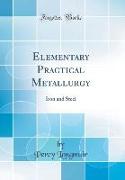- Start
- Elementary Practical Metallurgy
Elementary Practical Metallurgy
Angebote / Angebote:
Excerpt from Elementary Practical Metallurgy: Iron and Steel
In connection with the development of this process, the work of: Mushet must not be overlooked. Following Bessemer were many who, stimulated by his success, introduced other processes of steelmaking. Of these processes, the foremost, and one that is gaining ground yearly, is that of the regenerative furnace associated with the name of Siemens. This furnace gave rise to the now well-known siemens-martin process of steel making. The product of this process is a very uniform steel, and one that ofi'ers wide adaptability for structural purposes, ship and boiler plates, castings, etc. The latest development of the siemens-martin process is that of the Talbot open-hearth continuous method of steelmaking, which attracted so much attention at the Spring meeting of the Iron and Steel Institute, 1900. At this meeting the probable substitution in the near future of Bessemer steel by that of the open-hearth (siemens-martin) make was discussed. The ever-increasing strin geney of the specifications now applied to steel lends much probability to the eventual suppression of Bessemer steel by that of open-hearth make. In connection with these two methods of steelmaking, the dephosphorization process of Thomas and Gilchrist must be mentioned, resulting in the pro duction of basic steel. Germany and Bri tain annually produce large quantities of steel from basic Bessemer converters or basic lined open-hearth plants, thus utiliz in g irons for the production of good-quality metal, which, under other conditions, would be useless from a steel making point of view.
About the Publisher
Forgotten Books publishes hundreds of thousands of rare and classic books. Find more at www.forgottenbooks.com
This book is a reproduction of an important historical work. Forgotten Books uses state-of-the-art technology to digitally reconstruct the work, preserving the original format whilst repairing imperfections present in the aged copy. In rare cases, an imperfection in the original, such as a blemish or missing page, may be replicated in our edition. We do, however, repair the vast majority of imperfections successfully, any imperfections that remain are intentionally left to preserve the state of such historical works.
Folgt in ca. 10 Arbeitstagen
